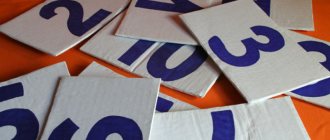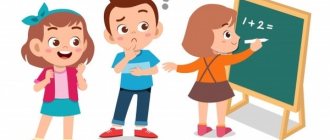The requirements of the modern school curriculum are such that by the time a child enters first grade, elementary mathematical concepts must be formed. These include knowledge of numbers and basic symbols, ability to count within ten and cope with simple math problems that require addition and subtraction for children aged 5-6 years. At the same time, as is known, preschool children absorb information that is presented in a playful form much faster and easier. Specialists from the development site “Razumeikin” sought to take these factors into account when preparing online tasks for teaching mathematics to 5-year-old children. All exercises are presented in an easy, interesting way.
The “Other Mathematical Concepts” section introduces the child to the basic symbols (“greater than,” “less than,” and “equal to”) and teaches them how to use them. Using our website you can study easily and productively. By completing math problems, 6-year-old preschoolers learn ordinal counting and the basics of measuring length, mass, and volume. Children learn to understand and analyze the dependence of the measurement result on the measurement value. Assignments as part of the online mathematics training program for children 5-6 years old give an idea of the basic geometric shapes and bodies in pictures, as well as a basic concept of tables.
When developing a set of exercises for children of senior preschool age, our specialists tried to make them not only as understandable and exciting as possible, but also truly useful in practical terms. Almost all online math tasks for 6-year-old children are designed in the form of a game and have detailed explanations. You can find them in the training video before the exercise. An explanation for the test tasks in the section “Mathematics for preschoolers 5-6 years old” is also given if the answer the child gave turned out to be incorrect or insufficiently complete.
How are results assessed?
For completing mathematics assignments for preschoolers 5 years old, the Razumeikin website provides a whole system of rewards. We are convinced that it helps to increase children's interest in learning and create positive motivation.
By completing the tasks in the “Mathematics for preschoolers 5 years old” section, kids receive a reward. Our website provides medals, cups, pennants and certificates.
Almost all task-games in the “Mathematics for 6-year-old children” section are graded depending on the attempt at which the child gave the correct answer. If necessary, you can return to the completed exercise. By doing the task in the section “Mathematics for preschoolers 5-6 years old” again, the child will be able to improve the previous result and receive a higher reward.
Before you start doing the exercises in the “Mathematics for children 5-6 years old” section, we recommend taking a test. The results obtained will help you understand which topics need to be discussed in more detail. In addition, parents will be able to determine which tasks in the “Mathematics for preschoolers 6 years old” section should be completed first.
Lessons with cards
Let's look at several exercises that help develop a child's mathematical abilities. To conduct them, you will need cards with numbers from 1 to 10. Of course, parents can quickly and easily make them. However, it is much better to involve the child in this process, entrusting him with the most interesting and responsible work. So, let's prepare training cards. We invite the preschooler to independently divide the landscape sheet into four equal parts and cut out cards along the lines. Having counted out 10 pieces, we give them to the child and ask them to write a number on each and draw the corresponding number of pictures. These can be circles, flowers, hearts, etc. If a child has difficulty writing any numbers, you should help him with this. After the cards are ready, you can start studying:
"Place it in order"
This exercise will help your child remember numerical values and the concepts of “more and less.” We ask the preschooler to arrange the cards in order, starting with the smallest and ending with the largest number. The exercise not only helps to consolidate the studied material, but also perfectly trains memory and imagination.
"Compare the numbers"
After showing the child two cards, we invite you to compare them. To begin with, the preschooler names the meanings of the numbers, then answers the question which one is greater and by how many units. Then you should replace one of the cards and repeat the same questions. This activity can continue for quite a long time until the child loses interest in it.
"Count the objects"
Since, in addition to numbers, various images are printed on the cards, it is worth inviting the child to count them. You can also complicate the task by preparing sheets with drawings of various animals and a number series from 1 to 10. Having counted the number of animals, the preschooler must circle the corresponding number. As a rule, children really like this exercise and do not cause them any particular difficulties.
"Missing Numbers"
The child holds the cards in his hands. An adult tells him two numbers, for example, 1 and 4. The young student finds these cards and places them on the table at some distance from each other. Now he must fill in the gaps between the numbers and find the two missing links. Accordingly, these will be cards with numbers 2 and 3.
Math games
Many children with a humanitarian mindset tend to consider mathematics a rather boring science. However, it is enough to show the children the other side of this subject and their opinion will change dramatically. Mathematical games for children 5-6 years old will help adults with this. Let's list some of them:
"Count the Claps"
This game contributes to the development of not only mathematical abilities, but also auditory perception. Clapping your hands with varying strength and frequency, you need to ask the child to count the number of beats. You can complicate the task by asking your child to reproduce what he heard.
"Hocus Pocus"
Having taken several small objects (sweets, buttons), the adult clenches them in his fists and hides them behind his back. Next, the child is given a simple math problem. For example: “I only have seven buttons. I hold four in my right hand, how many are held in my left fist?” If the preschooler answered correctly, you can invite him to switch roles. Let him come up with the problem himself and calculate its solution in his mind. If the child gave the wrong answer, you should hide the objects behind your back again, but in a different quantity.
"Find the odd one out"
An adult cuts out several dozen pictures of various categories from magazines: transport, food, plants, furniture, etc. Next, you should lay out images of the same theme on the table, adding a few extra objects to them. The child is given the task to count all the pictures, find “foreign” objects and name their number. Finally, the remaining images of the same category are counted.
"Say the number"
This game is a group game. The adult leader stands in the center of the circle formed by the children and one by one throws a ball to the kids, calling any number. Each child, having waited his turn, throws the object back, saying the next number in order. It is advisable to avoid repetition.
Drawing by points
When the child can easily cope with the above exercises, then you can offer him drawing by dots. This is a very exciting activity, since in most cases, you don’t know what kind of picture you will get in the end. Therefore, children enjoy connecting the dots by drawing lines in order from one number to another.
Walking games
Many people remember such games from childhood. Their essence is that the path along which you need to get from one place to another is marked on the playing field. And the players take turns throwing the dice, counting the number of dots rolled up and making a move, again counting. Counting is limited to numbers from 1 to 12, but the child learns to add. For example, 3 and 6 points fell on the dice. And the player’s task is to calculate how much 3+6 is. He can make a move only after he gets the correct result. You can involve the whole family in the game process, it will be an exciting pastime.
"Shop"
This role-playing game is familiar to many adults. After all, little inventors periodically involve their parents in their fun. So they become sellers and offer customers to buy products from them. Or they themselves come to the store to buy toys. Usually, various pieces of paper act as money. But it would be much more useful to take a few real coins or buttons and make very real payments with customers. Over time, the concept of “surrender” can be introduced. If cheese costs 3 rubles, and the buyer gives one five-ruble coin, you need to return the extra money to him. A child involved in the game will learn counting and simple mathematical operations much faster.
Eva, mother of seventh-grader Varya: “I taught my daughter to count in her head before school. We started with the simplest numbers, then introduced two-digit and three-digit numbers. Now Varya is 12, she counts faster than her dad and me. And the secret is very simple: the main thing is that the child is involved in the learning process. We introduced our daughter to money very early. When I picked her up from kindergarten, I first gave Varya 5 rubles for candy or chewing gum. She herself calculated whether she had enough money, how much should be left, etc. Gradually the amount increased to 20 rubles. My daughter managed to divide it into several purchases, making the necessary calculations in her head. Now mathematics is her favorite school subject, she consistently takes part in all Olympiads.”
Entertaining mathematics
Parents of preschoolers should use their imagination when developing activities. It is not at all necessary to conduct lessons sitting at the table when there are so many exciting things and phenomena around. So why not use them for arithmetic purposes? For example, you can involve children in preparing their favorite dishes, be it pizza or apple pie. Ask your child to count out two cups of flour and allow them to pour it into a prepared bowl themselves. Give your preschooler the task of fetching five eggs from the refrigerator, carefully placing them in a bowl. Let the child independently add three tablespoons of sugar, etc., to the dough. Such entertaining mathematics will not only bring great pleasure to the child, but will also be etched in his memory for a long time.
You can count anything, anywhere. To do this, it is not at all necessary to find time and set up your child for classes.
Most likely, he himself will not understand that he is involved in the learning process. For example, when getting ready for kindergarten in the morning, ask your preschooler to count the number of buttons on his shirt. And when you arrive at the hospital, determine the number of patients sitting in the queue. And how many objects to count can you find while walking down the street! Cars near the house, people at the bus stop, birds flying in the sky, floors of buildings - and this list is almost inexhaustible.
Alexandra, mother of eight-year-old Andrey: “My son and I learned to add and subtract at the age of 5. And they did it immediately in their minds, without using sticks or bending their fingers. Let's go somewhere, count the objects, and then add 1 to them. For example, three cars are parked near the store and then another one drives up to it. The son adds up in his mind and gives the answer. Later they began to add 2, 3, and so on in increasing order. Then they changed the order of calculations. They began to add a larger number to a smaller number. This, of course, was more difficult, but over time we got used to it. We walk a lot. At a minimum, a daily “walk” to the garden and back. Now we are already visiting the school, the journey to which takes 20 minutes in one direction. So there's plenty of time. We’re done with counting, now we’ve started learning English words using the same method.”
If a child refuses to count
Some children categorically refuse to learn counting skills even through play. Often the reason for this is the wrong approach of parents to conducting classes. Having tried to work with a preschooler a couple of times using the “sit and decide” scheme, many adults discourage their desire for mathematics for a long time. However, a dislike for counting may be explained by the child being overloaded with various developmental activities or sections. Or maybe the preschooler simply doesn’t like his parents’ reaction to incorrect answers. And there can be a huge number of similar reasons. How should parents behave if their children refuse to learn to count?
Be patient
Perhaps the child does not understand mathematics due to his young age. After all, not all five-year-old children have the ability to calculate. In addition, preschoolers with a humanitarian mindset can ignore numbers until they go to first grade. On the other hand, many of them by this time already read quite fluently and even know how to write. Therefore, you should not overreact to your child’s reluctance to count. After all, being successful “on all fronts” is simply unrealistic.
Use the method of “coercion by persuasion”
If a preschooler has an aptitude for mathematics, but simply does not want to learn, you need to convey to him the need for this process. After all, you can’t do without counting skills. We need to talk about this as often as possible, demonstrating this fact with real-life examples. So, while moving around the city on a bus with a child, a mother can say to him, “Please help me, my hands are full. Take some change from my jacket pocket, count out fifteen rubles and pay for the fare. Oh, I completely forgot, you can’t count. You'll have to deal with it yourself." By periodically creating such situations, you can gradually convince the child that it is time to learn to count.
Perform “number attacks”
If a child does not want to perceive numbers, you need to surround him with them. To do this, you should prepare a lot of cards with numbers and pictures. By hanging sheets of paper around the perimeter of the apartment and focusing attention on them from time to time, it will be much easier to teach your child to count. It is also necessary to include numbers in speech as often as possible when communicating with a child. You can play hide and seek with him, loudly counting down the time, teach poems like “one, two, three, four, five, the bunny went for a walk,” show unobtrusive educational cartoons with numbers, etc. Over time, the preschooler will certainly become interested in mathematics.
Conduct “sweet activities”
If a preschooler does not want to accept either classical or game methods of teaching counting, you can use a win-win technique. Perhaps not a single child will refuse sweets. So why not set the condition for children that they will receive candy only when they can name the correct amount. This will spur in preschoolers the desire to quickly master the skill of counting.
Thus, mathematics for preschoolers is an incredibly interesting and exciting science. The main thing is to choose the right form of education, which will be as enjoyable and unburdensome as possible for the child. Ideas for entertaining lessons are all around us; we just need to use our imagination and look at familiar things from a new angle.





